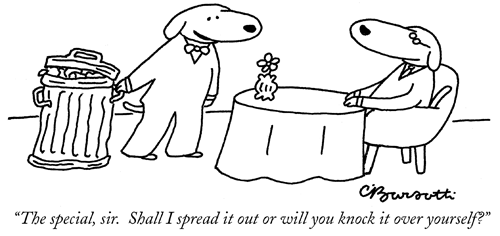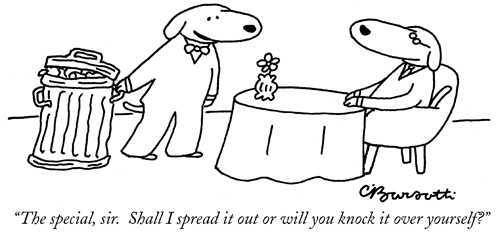

New York Dogs: Dog Cartoons of The New Yorker
Seventy-nine years of New Yorker dog cartoons suggest that the joke is on us
It’s not possible to fully appreciate just how many New Yorker cartoons have been published since 1925 until you attempt to lift their recently issued The Complete Cartoons of The New Yorker with one hand. Weak-wristed readers be warned. It’s not merely a coffee-table book: add a sturdy base to it and you have bedtime reading that doubles as a decent nightstand when you close the cover. Weighing in at over nine pounds, it’s as thick as the Manhattan Yellow Pages, the size and shape of the Ten Commandments tablet, and possessed of comparable heft and authority. It weighs more than many newborns. Having said that, The New Yorker’s latest offspring is not exactly comfortable to cradle in one’s arms. At least it doesn’t cry when you pick it up. But enough said about its embarrassment of riches.
On assignment to chronicle the venerable tradition of the New Yorker dog cartoon, I wondered how many days or weeks it would take me to extract them from the 68,647 cartoons compiled in this massive volume. Fortunately for me, the book’s 656 pages contain only 2,004 cartoons. The rest of the collection is contained on two searchable CD-ROMS that come with it. Looking for dog cartoons by a certain cartoonist in a particular decade is as easy as typing in a keyword. (You can access the cartoon bank’s search engine—and much more—at www.cartoonbank.com.)
To quote Hollywood’s most quoted folksy philosopher, this collection of all The New Yorker cartoons ever published is addictive, like a box of chocolates, and you never know what you’re going to find next. Dipping in and out of the book is the fun of it.
There are 1,702 dog cartoons identified by The New Yorker’s search engine, from the 1920s to the present day. Currently, the most-requested on the website is one of a dog sitting at a computer terminal, instructing another dog: “On the Internet, nobody knows you’re a dog.”
New Yorker cartoon humans are droll, world-weary, innocent, but not without guile. They’re cosmopolitan sophisticates, in tune with the latest trends, ready to trade gestalt therapists for personal trainers as the zeitgeist dictates, yet forever confused by the lightning-fast shifts of modern life. They wear their foibles on their sleeves.
It should come as no surprise, then, to realize that New Yorker dogs share similar traits—except they are wiser and more cynical than their human counterparts. In fact, The New Yorker’s dog cartoons aren’t really about dogs. Bourgeois New Yorker dogs are actually bourgeois New Yorker people with long noses, floppy ears and swishy tails. The humour, habits, obsessions and misbehaviours of our pets are deployed by cartoonists to satirize human folly and human absurdities. It’s only when we see ourselves as dogs that we realize how silly are the highfalutin human ideas and aspirations we take so seriously. The typical New Yorker cartoon reveals the puniness and insignificance of the big things in life, as in “James Joyce’s refrigerator,” with its to-do list: “1. Call bank. 2. Dry cleaners. 3. Forge in the smithy of my soul the uncreated conscience of my race. 4. Call Mom.”
Such gentle social satire is the oxygen The New Yorker breathes, and the de-fanged editorial topicality of their cartoons delivers new life to the magazine with each passing year. The New Yorker’s cartoon editor, Robert Mankoff, says that what makes these cartoons unique is that “they make a point about who we are, the way we live. New Yorker cartoons are not mean. They poke fun at ourselves. They are more than just funny jokes.”
There are numerous categories of New Yorker dog cartoons, and each one strives to peel off a layer of human defence with a variety of approaches as harsh as an acid bath or as refreshingly light as a hand wiping fog from a window. One oft-seen cartoon standard substitutes dogs for humans engaged in typical human activities or situations (two dogs gaze at a model of a typical doghouse placed on a coffee table: “It’s just the architect’s model, but I’m very excited.”), sometimes with unpredictably illuminating results that rely on the multiple meanings of many English words (woman explaining to husband their dog dressed in cape and top hat: “Howard, I think the dog wants to go out.”)
At times the demons of our darker side come through: a scowling dog tells the bartender dispensing Kibbles and Bits to “Leave the box”; while two female dogs sitting at the bar bitch about male dogs: “They’re all sons of bitches.” But most often our human failings are served up as a feast of satirical tidbits, as in one frustrated dog saying to another: “Pee on the carpet! That’s your solution to everything.”
A typical New Yorker dog cartoon uses our canine friends to shed light on everything from human relationships to the latest psychobabble, and to crack open our view of life with cliché-busting glee (an X-ray reveals that a dog has actually eaten some homework), sometimes to heartrending effect (lovestruck dog with cat cuddled up to him says to devastated ex-partner dog, “We laugh at the same things.”)
Another strain of New Yorker dog humour reveals us, usually less than flatteringly, as dogs—or perhaps our dog stand-ins in the human world—might see us (a retreiver’s thoughts after dutifully fetching a stick: “It’s always ‘good dog,’ never ‘great dog.’”). There are New Yorker dogs depicted in a human context, calculated to prick the hot-air bubbles of our pretensions and to expose our hypocrisies and prejudices, as when the caption above a dog gazing at the heavens reads: “Without making a big deal out of it, dogs often question the existence of an almighty.”
Yet more subtle variations on this theme specialize in using dogs to caricature our neurotic preoccupations and our most perplexing phobias (dog on a psychiatrist’s couch complains: “They moved my bowl,” while another confesses: “They think they’re accidents”). They lampoon our philosophies of life (same dog on psychiatrist’s couch ruminates: “I do what they tell me, I eat what they give me. How do I know they’re not a cult?”), parody our biases (two shaggy dogs remark on a clipped Poodle: “I don’t trust a dog that doesn’t shed”), and chronicle the social issues du jour: a professional dog walker is seen marching his charges down the street, single-file, at gunpoint.
Through the decades we see deft commentary on the latest social, economic and political realities (businessman to his dog: “I’ll lay it out for you. We’re cutting back, and we no longer need a dog” ID 22665) and other signs of the times (dog therapist asks a group therapy session of dogs: “O.K., who else has experienced the best-friend relationship as inadequate?”) that tap in to our deepest insecurities.
Occasionally, a cartoon will simply highlight a cultural quirk or social tic in a way that requires no deeper explication: “The Dog Formerly Known as Prince” steps out from a doghouse crested above the doorway with the symbol of the Artist Formerly Known as Prince.
And then there are the dog cartoons that are actually about dogs beings dogs: canine waiter hauls an overflowing trash can to dog seated at restaurant table: “The special, sir. Shall I spread it out or will you knock it over yourself?” ID 42887 or two dogs sniffing each other’s behinds: “What say we find another way to say hello?”
It’s doubtful that dog behaviour has changed significantly since 1925, even if the way we perceive dogs has altered, but the human society in which our pets so masterfully coexist has undergone a complete transformation over the past eight decades, and we humans have learned a few new tricks along the way. If our sense of humour has changed along with our collective situation, then it stands to reason that the way we use dogs to comment on the human condition has evolved along the same path, and one place to locate the trajectory of that change is in the New Yorker’s dog cartoons.
Those which date from before the current cultural epoch (say, before 1990 or thereabouts) seem not so much stale or quaint as blunted, their edges dulled, their ability to skewer us—and the possibility of achieving the self-effacing sense of redemption that comes from that power—having come and gone. Case in point: the humor in some of the earliest dog cartoons eludes me as completely as the dog on the Internet joke would baffle a reader from the 1920s. In contrast, the socially attuned and self-aware humour of the present era has me laughing out loud at how unerringly the current crop of New Yorker artists punctures the thin veneer of our ever-more-inane-seeming existence.
The best New Yorker cartoons refuse to let you off the hook, even when the spectacle of human folly is transmitted through the avatar of a mirthful dog. The laugh is on us. And we are better off for it.
If the future generations of robots who dominate the planet a millennium or two hence unearth a mouldy, dog-eared copy of The Complete Cartoons of the New Yorker and mistake its hand-drawn icons for a Rosetta stone of the paleohomosapiens era, our civilization’s reputation won’t fare too badly if those superior beings have been programmed with a human sense of humour and a love of cyberdogs.
Comments (0)
Join the newsletter and never miss out on dog content again!
"*" indicates required fields
By clicking the arrow, you agree to our web Terms of Use and Privacy & Cookie Policy. Easy unsubscribe links are provided in every email.